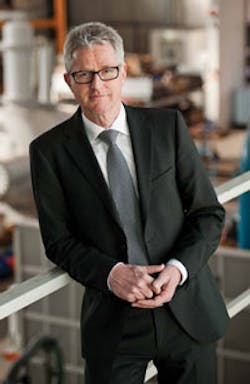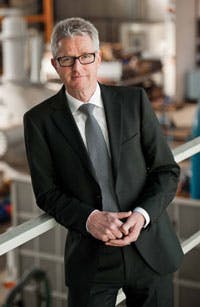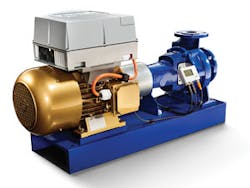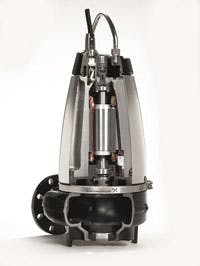How Can Pumps Achieve Better Energy Efficiency from Today's Standards?
In a new WWi article series, we will be posing questions to several executives from major manufacturers of key equipment used by the water and wastewater industry. First up is pumps. With the pumping of water accounting for 10% of the world's energy supply, it's time to find out how companies are improving energy efficiency.
Avoiding Oversizing
Dr. Ing. Soenke Brodersen, Senior vice president research, KSB Aktiengesellschaft
Four different technical approaches are available that can help lower a pump system's energy requirements. Pump manufacturers can contribute to a reduction in electricity consumption by providing pump selection software, matching impeller diameter to actual operating conditions, offering variable speed pumps sets and using extremely energy-efficient motors.
Hydraulic optimisation of a planned system begins with correct pump selection in order to avoid the common mistake of oversizing. In this context, pump selection software plays a crucial role. It allows the user to gain access to expert know-how: pump systems can be designed and selected according to commercial or technical parameters.
When compared with a pump whose impeller for commercial or manufacturing reasons has a fixed standard diameter, a pump whose impeller diameter has been matched to its operating point can achieve energy savings of several thousand euros, as its performance is tailored to the needs of the system.
Pump speed control offers by far the greatest savings potential if you think of clean water transport. What is perfectly normal in other fields of application, i.e. matching power input to actual demand, is still far from standard practice in many branches of industry. In practice, a detailed analysis of a pump's operating behaviour often reveals that it is not running at its optimum, energy-efficient operating point.
A common cause for this is operation at off-design conditions due to either system oversizing or normal temporary variations in flow rate arising from system processes. If power input is not adjusted to demand via some form of system control, valuable energy is wasted. In the case of closed-circuit systems, energy savings of up to 60% can be achieved depending on load profile.
Company Developments
To match new requirements KSB developed a new high-efficiency electric motor called SuPremE. In contrast to conventional synchronous motors, this motor does not contain any magnetic materials, such as rare earths, which are regarded critical raw materials and which cannot be mined without considerable environmental impact in the countries of origin.
Combined with the PumpDrive variable speed system, speeds ranging between 0 and 4,200rpm are possible as a standard. They have at least 15% less power dissipation than that prescribed by Regulation EC 640/2009 for efficiency class IE3 from 2015 or 2017, depending on the motor rating. This means that the motors already reach efficiency level IE4 as per IEC/CD 60034-30 Ed. 2. In contrast to asynchronous motors, synchronous reluctance motors still have a good efficiency when they are run at partial load. This is often the case in day-to-day operations, where many motors operated in speed-controlled applications mainly run at reduced speed.
Variable Speed Drives
Peter Røpke, Group executive vice president, business development, Grundfos
Generally speaking pump manufactures will seek to increase efficiencies by having better motors and better hydraulics but aside from this the use of variable speed drives will be the area where most innovation might be seen.
The use of variable speed drives in connection with sensors will enable energy savings by adapting to load profiles for the specific sewage system. That is only the first obvious step in this direction. Energy optimisation might be an important issue but a reliable pump operation is a must when dealing with wastewater. This reliability is even more important to strive for. Intelligence in the form of sensors and algorithms that will predict and detect faults and abnormalities must be integrated in the pumps making the need for service much smaller. An intelligent sewage management system that solves existing and emerging problems like sedimentation, clogging of individual pumps and load fluctuations would be a future scenario which definitely would be possible.
Collection of data from whole sewer grids in large cities like Berlin has already been seen and the information extracted from this can be used to build control systems to run pumps in modes where it has been proven that problems will not occur. Another effect will be that the treatment efficiency on wastewater treatment plants will be optimized as well by sending information about water quality and flow rates in advance. The most important issue will still be that you want to see as little to your sewage pump as possible.
Company Developments
Grundfos has launched its S-tube equipped sewage pumps which led to the highest efficiencies for a whole program. At the same time this kind of impeller has proven that clogging could be brought to a level much superior to any sewage pump seen before. In near future this kind of pumps will be extended to even larger sizes and a broader flow ranges.
Designed for demanding situations, the Grundfos SE and SL pumps are now released and available with the innovative technologies and functionality that Grundfos brings to pumps and pump systems, ensuring optimised performance.
Hydraulics, Motors and Controls
Anders Fredriksen, Head of wastewater transport at Xylem
The three fundamental functions of a pump - hydraulics, motors and controls - all have to be superior in performance and work seamlessly together in order to reduce energy consumption and ensure optimum performance. There is no point in one element being of an excellent standard if the other functions perform to a lesser degree and as such, reduce reliability or increase the energy consumption. By combining state-of-the-art hydraulics, premium efficiency motors and intelligent controls energy consumption can be reduced by as much as 50%.
Ideally the impeller should move axially upward when necessary to permit bulky materials or tough debris to pass through smoothly. This significantly reduces stress on the shaft, seals and bearings. Premium efficiency motors for wastewater pumping should be optimized for this application. Some models feature a 'Line Started Permanent Magnet', or LSPM design which can also aid energy efficiency. Motors should of course comply with international Premium Efficiency Standard (IEC 60034-30), commonly referred to as IE3. LSPM technology supersedes the nominal standard by up to 4%.
Today there are generally two types of controls for wastewater pumping systems. Conventional on/off controls, which are simple to use but give limited opportunities to optimize functionality; and variable frequency drives which provide more fine-tuning possibilities but can be complicated to install and difficult to optimize. Intelligent controls solve this issue by combining the advanced functionality of a drive with a simple intuitive interface.
While the internal functions are multifaceted, the interface should be simple to operate. Intelligent controls can enable a pumping system to be pre-programmed to handle any wastewater handling situation, making it very easy to install and operate. They can also optimize energy use and reduce energy consumption by up to 30% compared to conventional on/off systems.
In Louisiana in the US our Flygt Experior solution reduced the total energy consumption of four wastewater pump stations by 50%. These stations were experiencing serious clogging issues and have not required any maintenance call outs since the Flygt Experior pumps were installed in May last year.
Similarly, at a municipal wastewater plant in Dalarna in central Sweden Xylem's Flygt Experior solution reduced the energy consumption of the station by 50%. At another wastewater plant in Sigtuna, Sweden, in 2011 we installed a Flygt SmartRun pump controller on each of the pumps in the station which reduced the energy requirement by 30%.
Company Developments
Flygt Experior Premium Efficiency Motors, available up to 70 kw, or 105 hp, have been optimized for wastewater pumping applications, including some models featuring a 'Line Started Permanent Magnet', or LSPM design. All of the new motors comply with international Premium Efficiency Standard (IEC 60034-30), commonly referred to as IE3 and with the LSPM technology the Flygt motors supersede the nominal standard by up to 4%.
Flygt Experior's SmartRun intelligent controls enable the pumping system to be pre-programmed to handle any wastewater handling situation, making it very easy to install and operate. The SmartRun controls optimize energy use and can reduce energy consumption by 30% compared to conventional on/off systems.
SmartRun solves this issue by combining the advanced functionality of a drive with a simple intuitive interface. While the internal functions are multifaceted, the interface is simple to operate. Xylem's Flygt Experior uses the company's 'Adaptive N-technology' which enables the impeller to move axially upward when necessary to permit bulky materials or tough debris to pass through smoothly, significantly reducing stress on the shaft, seals and bearings.






